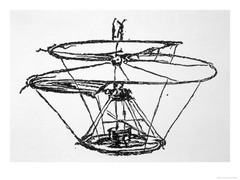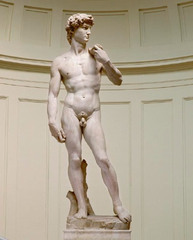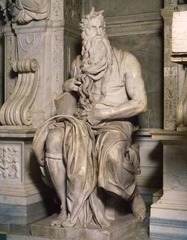How did Michelangelo paint the frescoes of the Sistine Chapel?
He painted them as a narrative story.
What is the name of the painting below?
The Creation of Adam.
It took Michelangelo 4 years to paint the ________ of the Sistine Chapel.
Ceiling.
In addition to being a religious symbol, the statue David also _______________________.
Served as a reminder of Florence’s republican state.
What were Michelangelo’s feelings about painting in the Sistine Chapel?
He was less than happy.
What does David’s expression suggest?
That he is about to encounter danger.
What is Pieta?
A sculpture of Mary holding Jesus’ body
Which of the following is a tomb monument in the Vatican basilica of Saint Peter?
Pieta.
The Sistine Chapel paintings resulted in a new powerful style in ______ Renaissance.
High.
What is the overall theme of the Sistine Chapel paintings?
God’s relationship to man.
What is the title of the work below?
The New Sacristy.
What physical characteristic does Michelangelo commonly used in his frescoes?
He uses strong muscular forms.
How does Michelangelo emphasize that God made Adam in his own image in The Creation of Adam?
Adam’s form and pose mimic God’s.
What symbols did Michelangelo include in the sculpture titled New Sacristy?
A moon and gold to symbolize night.
What style of portraiture that Raphael uses in The Small Cowper Madonna was likely influenced by Leonardo? (above)
the tilt of the head, reflecting a pyramid shape
What does tromp l’oeil arch mean?
fool the eye arch
What is Plato’s gesture in School Of Athens, and what is meant by it?
He points up to heaven, signifying that everything is a reflection of Forms that reside in heaven.
What is the mood in Disputa?
solemn and majestic
Which of the following best describes the scene in Disputa?
a dream of heaven that has been opened up
Which of the following of Raphael?s work makes a reference to a time era known as the Golden Age?
School of Athens
What is Aristotle’s gesture in School Of Athens, and what is meant by it?
He motions towards Earth, signifying that everything can be understood from gathering scientific knowledge from the material earth.
What Master’s influence can be seen in The Small Cowper Madonna? (above)
Leonardo da Vinci
According to the lecture explanation of the painting Pope Leo X with Cardinals, what clues explain to the viewer the type of mood in the painting?
No one in the painting is looking at each other.
What is Plato’s gesture in School Of Athens, and what is meant by it?
He points up to heaven, signifying that everything is a reflection of Forms that reside in heaven.
Who are some of the characters identified in the fresco below?
names common to the Christian faith – Jesus, Mary, John the Baptist, and many other saints
What style of portraiture that Raphael uses in The Small Cowper Madonna was likely influenced by Leonardo? (above)
The tilt of the head, reflecting a pyramid shape.
What is the mood of the painting Pope Leo X with Cardinals?
Uneasy, tense.
What is Aristotle’s gesture in School Of Athens, and what is meant by it?
He motions towards Earth, signifying that everything can be understood from gathering scientific knowledge from the material earth.
Which of the following people is included in the painting School of Athens?
Aristotle.
Which of the following techniques, developed by a fellow Renaissance artist, did Raphael use in one of his painting?
Pyramidal figures.
Which of the following best describes the scene in Disputa?
A dream of heaven that has been opened up.
What scene is depicted in the painting Pope Leo X with Cardinals?
None of the above.
What does tromp l’oeil arch mean?
Fool the eye arch.
What Renaissance technique does Raphael use in School of Athens? (below)
Perspective.
What is the mood in Disputa?
Solemn and majestic.
What is sfumato?
The technique of blending colors so that there is no outline.
How is Leonardo da Vinci?s The Last Supper different from traditional depictions?
A and B are correct.
Which of the following is a characteristic of the Mona Lisa, and different from other traditional works?
All of the above.
How was da Vinci?s The Last Supper created, causing the belief that the painting will be completely lost one day?
He used a very thin layer of dry plaster to create a version of a fresco that shortly began to peel away from the wall.
Which of the following titles was da Vinci given because he did a little bit of everything and was very gifted at all that he did?
Renaissance Man.
What significance do Leonardo’s technical achievements have?
Scientists have actually built some of them.
Which of the following is not one of da Vinci’s contributions to technology?
Ideas for space travel.
Which of the following is true about the Mona Lisa?(1)
It is highly replicated work.
What is one geometrical fact explained in the lecture that reflects the mathematical technique da Vinci used in The Last Supper?
He uses the coffers of the ceiling to place Jesus in the mathematical center, and to create an illusion that extends the room beyond what is visible.
What symbolism does da Vinci use in his representation of The Last Supper?
The shape of Jesus resembles a triangle.
According to the information presented in the lecture, which of the following inventions commonly used today was first designed by Leonardo da Vinci?
A flying machine.
What was the original concept of Vitruvian man, according to Roman engineer and architect Vitruvius?
For a man to be perfect, his hands and feet would touch the circumference of a circle when extended.
What is Vitruvian man?
World renowned drawing of the correct human proportions.
What did da Vinci add to the concept of Vitruvian man?
Notes written in reverse at the beginning and end of the page.
Which of the following is true about the Mona Lisa.?(2)
It is highly replicated work.
Which artist created Pieta, the sculpture seen below?
Michelangelo.
Which of the following are characteristics of the High Renaissance?
Gravity and balance of individual parts to the whole.
What was the Counter-Reformation?
A rebuttal from the Catholics to seek internal reform and renewal.
Where did much of the Counter-Reformation take place?
Council of Trent.
What was the benefit of using oil versus tempera paint?
Oil paint is more flexible and allows artists to make changes easier.
How is tempera paint made?
By binding pigments with egg yolk.
Which of the following projects was commissioned by popes?
Sistine Chapel.
What is the artistic term for an image of Mary holding her dead son Jesus?
Pieta.
Who commissioned most of the work during this time period?
The papacy.
How did the papacy behave during the High Renaissance?
They lived like princes.
What religious denomination was born out of the Reformation?
Protestantism
One project commissioned by the papacy was the reconstruction of _________________.
St. Peter’s Basilica
What material did Michelangelo use to sculpt David?
marble
In which of these areas did Leonardo da Vinci make discoveries?
He foreshadowed modern theories of the formation of continents.
Leonardo Da Vinci, also referred to as a Renaissance man, was a dedicated ________ and _________.
artist…scientist
Why does Leonardo da Vinci fit the term “Renaissance man”?
A “Renaissance man” is one who excels at many things. Leonardo was an accomplished scientist, architect, engineer, painter, designer. So he knows a LOT.
Who led the Protestant Reformation?
Martin Luther
What led the Protestant Reformation?
Martin Luther’s “Ninety-Five Theses”
One major change that occurred during the High Renaissance time period was that artists began to be __________.
commissioned by private sources
What scene is depicted in The Last Supper?
when Jesus told the apostles that one of them would betray him
Who commissioned Michelangelo to paint the Sistine Chapel?
Pope Julius II
What is seen in the image below?
leonardo da vinci flying machine
Which of the following is not one of Michelangelo’s famous works?
Peter
What is the name of the sculpture below?
san pietro in vincoli
Who is the person in the sculpture below?
Moses
How did da Vinci create a mood in The Mona Lisa?
The Mountains in the background are dark and cloudy. (makes it look mysterious)
Which pope commissioned Raphael after the artist had gained fame in Florence?
Pope Julius II






